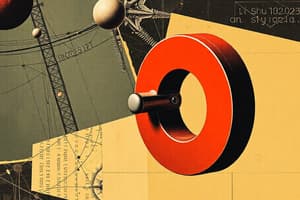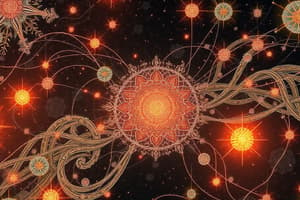Podcast
Questions and Answers
Which of the following scenarios best illustrates the effect of friction?
Which of the following scenarios best illustrates the effect of friction?
- A toy car continues to move at constant speed when it receives a gentle push on a polished floor.
- A person walking on an icy surface experiences reduced traction and frequently slips. (correct)
- A hockey puck glides on an air hockey table until it hits a side rail and changes direction.
- A ball rolling on a smooth glass surface maintains its speed for a longer duration compared to a rough carpet.
Which action primarily showcases force altering an object's shape rather than its motion?
Which action primarily showcases force altering an object's shape rather than its motion?
- A bicycle accelerates as the rider pedal with increased effort.
- A tennis ball is struck with a racket, causing it to reverse direction.
- A door swings shut as it is pushed with enough force.
- A lump of clay is molded into a new form with considerable pressure. (correct)
Which use of magnets relies primarily on its ability to be incorporated into appliances for closure, rather than for sound or data processing?
Which use of magnets relies primarily on its ability to be incorporated into appliances for closure, rather than for sound or data processing?
- The magnets included in the internal working of speakers which allows to emit sound.
- The magnet used inside a refrigerator door, secured by a rubber casing. (correct)
- The electromagnetic components inside headphones, that help in generating audio.
- The tiny magnets inside the storage devices of computers used for data storing.
Which of these correctly describes the properties of a type of a magnet which uses an electric current?
Which of these correctly describes the properties of a type of a magnet which uses an electric current?
In the absence of friction, which of the following effects on motion would be most likely?
In the absence of friction, which of the following effects on motion would be most likely?
Which of the following best describes the origin of the term 'magnet'?
Which of the following best describes the origin of the term 'magnet'?
Which of these is NOT a typical shape for a man-made magnet?
Which of these is NOT a typical shape for a man-made magnet?
If a magnet attracts a nail, which of the following is the correct characterization of the nail?
If a magnet attracts a nail, which of the following is the correct characterization of the nail?
What is the primary function of friction?
What is the primary function of friction?
Considering the behavior of magnetic poles, what would happen if you tried to bring two south poles together?
Considering the behavior of magnetic poles, what would happen if you tried to bring two south poles together?
Which of these statements accurately describes the force exerted by a magnet?
Which of these statements accurately describes the force exerted by a magnet?
What distinguishes magnetic materials from non-magnetic materials?
What distinguishes magnetic materials from non-magnetic materials?
Which scenario accurately describes the interaction involving magnetic force?
Which scenario accurately describes the interaction involving magnetic force?
A ball slows down and stops rolling due to ______ between the ball and the ground.
A ball slows down and stops rolling due to ______ between the ball and the ground.
We are able to walk on the ground thanks to ______.
We are able to walk on the ground thanks to ______.
When a force acts on an object at rest, it can make it start ______.
When a force acts on an object at rest, it can make it start ______.
______ are found in many electrical appliances such as telephones and computers.
______ are found in many electrical appliances such as telephones and computers.
______ are temporary magnets that act as magnets when electricity flows through them.
______ are temporary magnets that act as magnets when electricity flows through them.
Long ago in ______, an old shepherd named Magnus found a piece of rock that could pull things made of iron towards itself.
Long ago in ______, an old shepherd named Magnus found a piece of rock that could pull things made of iron towards itself.
Magnets can pull or ______ certain materials.
Magnets can pull or ______ certain materials.
Materials such as iron, nickel, cobalt, and steel are attracted by magnets. They are called ______ materials.
Materials such as iron, nickel, cobalt, and steel are attracted by magnets. They are called ______ materials.
The ends of a magnet are called its ______.
The ends of a magnet are called its ______.
When two like poles such as N-N or S-S, are brought together, they ______ each other away.
When two like poles such as N-N or S-S, are brought together, they ______ each other away.
The South Pole of one magnet ______ the North Pole of the other magnet.
The South Pole of one magnet ______ the North Pole of the other magnet.
A ______ is a pull or push applied on an object.
A ______ is a pull or push applied on an object.
______ is a type of force that we experience in our daily life. It slows down a moving object or stops it completely.
______ is a type of force that we experience in our daily life. It slows down a moving object or stops it completely.
Flashcards
Friction
Friction
A force that opposes motion between two surfaces in contact.
Force
Force
A push or pull that can change the motion, shape or size of an object.
Electromagnet
Electromagnet
A special type of magnet that can be turned on and off by using electricity.
Magnet
Magnet
Signup and view all the flashcards
Effects of Force
Effects of Force
Signup and view all the flashcards
What is a magnet?
What is a magnet?
Signup and view all the flashcards
What are magnetic materials?
What are magnetic materials?
Signup and view all the flashcards
What are non-magnetic materials?
What are non-magnetic materials?
Signup and view all the flashcards
What are the poles of a magnet?
What are the poles of a magnet?
Signup and view all the flashcards
What happens when like poles of magnets interact?
What happens when like poles of magnets interact?
Signup and view all the flashcards
What happens when unlike poles of magnets interact?
What happens when unlike poles of magnets interact?
Signup and view all the flashcards
What is force?
What is force?
Signup and view all the flashcards
What is friction?
What is friction?
Signup and view all the flashcards
Where is the magnetic force strongest?
Where is the magnetic force strongest?
Signup and view all the flashcards
What are Electromagnets?
What are Electromagnets?
Signup and view all the flashcards
What are Magnets?
What are Magnets?
Signup and view all the flashcards
What are the effects of Force?
What are the effects of Force?
Signup and view all the flashcards
Study Notes
Magnets: Definition and Properties
- Magnets are special stones or man-made objects that interact with some metals. A shepherd named Magnus discovered naturally occurring magnets in Magnesia (a region of ancient Greece).
- Natural magnets include magnetite and lodestone, found in rocks.
- Man-made magnets are typically made of iron or steel and come in various shapes, including U-shaped, horseshoe, bar, rod, ring, and button magnets.
- Magnets attract certain materials known as magnetic materials.
- Magnetic materials include iron, nickel, cobalt, and steel; examples include nails and paperclips.
- Non-magnetic materials are not attracted to magnets. Examples include gold, silver, aluminum, copper, wood, paper, plastic, glass, and clay.
Magnet Interactions and Forces
- Magnets attract magnetic materials due to the magnetic force.
- Magnets have two poles: north (N) and south (S).
- The magnetic force is strongest at the poles and weakest at the center.
- Like poles (N-N or S-S) repel each other.
- Unlike poles (N-S) attract each other.
- A force is a push or pull that can cause changes in motion or shape.
- Friction is a force that slows or stops motion.
Effects of Forces on Objects
- Forces can cause objects to:
- Start moving if they are at rest.
- Change their speed or direction if already moving.
- Change their shape or size.
- Stop moving if they are currently moving.
Uses of Magnets
- Magnets are essential components in many everyday electrical devices.
- Magnets in telephones, headphones, and speakers generate sound.
- Small electromagnets are used inside computers and video recorders to manage information.
- Magnets are used to keep refrigerator doors closed, as refrigerators often contain steel.
Additional Magnet Information
- Electromagnets are temporary magnets. They act as magnets only when electricity flows through them.
Studying That Suits You
Use AI to generate personalized quizzes and flashcards to suit your learning preferences.




